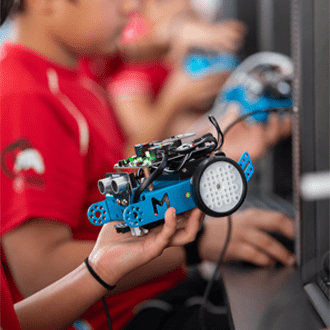We use cookies to improve your online experiences. To learn more and choose your cookies options, please refer to our cookie policy.

We have continuously extolled the virtues of STEAM education throughout the year. STEAM, or Science, Technology, Engineering, Arts, and Mathematics education, combines all the technical skills and exploratory benefits of STEM with the creative development of Arts education, providing a well-balanced recipe of learning for each child. In many ways, STEAM has already been an important part of our education, thanks to the balanced curriculum of the International Baccalaureate. But only recently did it make its way to our Primary Years Programme in the form of our brand-new IB STEAM programme. What makes STEAM so important?
One of the most critical benefits of STEAM education is the cultivation of 21st century skills. These are already certainly a big part of education at SISD with the International Baccalaureate. However, this is even more effective when introduced from an early age – children are taught these skills during their formative years, allowing for a smooth transition into learning them when they reach the later years of their schooling. Ms. Gullruq Rafiq, PYP teacher, reports how the STEAM programme prepares children for the changing future. “STEAM is a program that allows our students to engage with 21st century skills. In a rapidly changing digital society, children need to be prepared with critical thinking opportunities. These can be as basic as analyzing the steps of the scientific method or as deep as using a question matrix to decipher perspective.” Ms. Rafiq also noted how SISD’s STEAM programme is implemented in a way that helps students discover their own ways of learning, and how it transcends individual subjects and topics: “We embed our practice through a transdisciplinary collaborative teaching model and encourage student autonomy in their inquiry. In the physical classroom, this would involve a variety of learning tools both digital and tangible, construction material, visible thinking routines, teacher demonstrations and a language rich environment. Using communication as a base skill, we build a web of learning.” She also notes that the new IB STEAM programme has thus far been well-received by students. “STEAM has become a favourite subject for most students, as they enjoy the diversity of the program and the co-teaching bilingual approach from the teachers.
One of our Grade 2 students, Ian, has this to say about STEAM: “I love STEAM – my favourite part is the Engineering and Maths areas. I am hoping to be an engineer when I grow up, as I love constructing and building things. I have so much fun making and building at school as part of this programme.” The many new skills explored in STEAM allow children to find out their aptitudes and interests even in their early childhood. This is an important consideration for educators – the fact that children are not too young to appreciate STEAM concepts.
Because of the transdisciplinary nature of STEAM, as well as how it integrates the scientific and rational with the artistic, it provides unique opportunities to develop creative and problem-solving skills in children. By connecting these two traditionally separated educational arenas in a meaningful way, children are encouraged to think innovatively and creatively, which may not have necessarily been encouraged in systems where each discipline is taught separately. One of the most important ways this is shown is in design thinking, a discipline that requires artistic, human-oriented thinking, yet implemented in the context of highly technological backgrounds. One of the most famous design thinkers of all time, Steve Jobs, pioneered the smartphone age and changed the way we thought about computers. He once said, “Creativity is just connecting things. When you ask creative people how they did something, they feel a little guilty because they didn’t really do it, they just saw something. It seemed obvious to them after a while. That’s because they were able to connect experiences they’ve had and synthesize new things.” This reflection of connecting and synthesizing is a powerful component of transdisciplinary learning in STEAM.
Our enhanced IB STEAM programme has been a great success and our young learners are loving the new concepts and opportunities for learning. If you’d like to know more about our programme, or consider your PYP-age children for it, contact us and we will be happy to provide you with all the details of this unique programme.